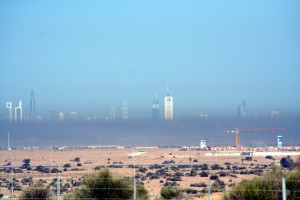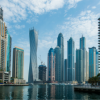 While the overall air quality in Dubai is better than in many developed countries, air quality is deteriorating and may need government intervention as the country grows.
While the overall air quality in Dubai is better than in many developed countries, air quality is deteriorating and may need government intervention as the country grows.
The activities the citizens now take for granted – new home construction, commercial construction and driving cars contribute to the rising amounts of air pollution.
Monitoring Air Quality In Dubai
One measure of air quality is particulate matter – small particles of dust, sand or chemicals – and it’s currently measured at an elevated, unhealthy level. In addition, nitrogen oxide, the product of combustion of fossil fuel, and smog are increasing.
Some local authorities are already taking notice. In some areas, authorities have setup monitoring stations that are connected to their websites, allowing anyone to track the elevated levels of air pollution. Specifically, they are tracking at particulate matter pollution, known as PM10. These small particles are only 10 micrometers across – and if you have been out of school for a while, a micrometer is only a millionth of a metre.
They are also tracking levels of PM2.5, which is even smaller. This particulate is particularly troubling because it is small enough to pass directly into human lungs. In studies, elevated levels of PM2.5 has lead to lung cancer and premature death.
This is perhaps most troubling to those who workout outside – runners, in particular, who tend to breathe more deeply than the average person. Their risk of inhaling unhealthy levels of PM2.5 is much greater than the general population. Many runners have now taken to exercising indoors on equipment like running machines and elliptical machines. For the best treadmill experience, some have even taken the precaution of wearing a face mask while working out.
Construction workers, and other workers who spend the bulk of their working day outside are also at increased risk.
A recent study concluded that there is an immediate need to know more about how increasing levels of air pollution is tied to human activities such as construction and the widespread use automobiles. It also looked at particle and ozone forming substances blown into the atmosphere by mineral excavation, commercial transport, and hydrocarbon industries.
Both particulate matter and ozone are what is known as secondary pollutants. In other words, they form as a result of reactions with primary pollutants. Because of this, the study also concluded that the whole region must be evaluated, not just Dubai. Achieving regional cooperation on cleaner air might be a challenge, but the least Dubai can do is to make these countries aware of their contributions to the air pollution problem and make them aware of their responsibilities.
The study, which was published in the Total Environment Journal, was conducted in the University of North Carolina in the United States. Use advanced mapping software, they concluded that air pollution was directly responsible for “hundreds” of deaths in Dubai each year. The scientists who authored the study are consulting with the Dubai government on its environmental strategy.
In the end, it may be necessary to setup a framework within local governments, industries, and research bodies that are contributing to Dubai’s air pollution issue. A collaborative approach to sharing data, technology, and ideas is the first step to cleaning up the air in Dubai.


 United Arab Emirates
United Arab Emirates


Recent Comments